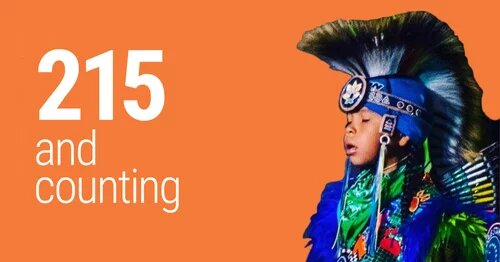
Tuesday, September 20, 2022
Acknowledging Orange Shirt Day and committing to understanding reconciliation is not just a day, but a journey
The National Day For Truth and Reconciliation, also known as Orange Shirt Day, is a national day every September 30 to recognize the legacy of the Canadian Indian Residential School System.
The National Indian Residential School Crisis Line provides 24-hour support to survivors and their families toll-free at 1-866-925-4419.
Photo by June Taylor.
215 and counting
The focus of this campaign by the AMAPCEO Indigenous Circle is “215 and counting.” Below, Indigenous Circle Chair Waasmowin-Mnidoo explains, in her own words, why.
Why 215 and counting?
On May 28, 2021, the bodies of 215 children were discovered in a burial site at the grounds of the Kamloops Indian Residential School. Collectively, Indigenous, Métis, and Inuit knew of missing children in Indian Residential Schools, but there is a difference between knowing and knowing, at least for me—and this knowledge brought me to my knees.
I felt like my spirit wanted to run; I felt it quickening with sadness, anger, and powerlessness. I tightly held my chest, forcibly consoling my spirit. I cried. Powerless to hold those young spirits in a loving embrace and powerless to protect them from pain, I cried. What could I pray for when the worst has already been done?
Why 215 and counting?
It may seem morbid to anticipate the reclamation of more buried Indigenous, Métis, or Inuit children on Indian Residential School grounds, but that is the reality. According to the Truth and Reconciliation Commission (TRC)’s Report, there are 2,800 children who were enrolled in residential schools who never returned to their parents’ homes. Murray Sinclair has said the number of so-called “missing” children could be thousands more— as many as 25,000. We know this to be true.
Why 215 and counting?
Indian Residential School survivors have told stories of missing children, of witnessing murder, and of being subjected to experiments and neglect. Not only are these survivors dealing with their own trauma of Indian Residential Schools, on their small shoulders they also bear the burden of witnessing, giving testimony, and carrying the spirit of these “missing” children.
Despite being met with skepticism, survivors honoured those children, fought for their recognition, and demanded their return via the TRC Calls to Action 71 to 76: Missing Children and Burial Information. It is now our turn to honour the survivors and continue the search for and return of the “missing” children to their families and community.
The Circle asks those who wear the buttons to know why we say “215 and counting,” and to be able to communicate to others their commitment to the TRC Calls to Action.
This is reconciliation.
What reconciliation means to me
Indigenous Circle Vice-Chair Valerie Milburn shares what reconciliation means to her.
What does reconciliation mean to me? Well, it changes every day. The more I speak to and learn from people who have been and still are affected by colonization, and the more I learn about how our policies, laws, and “activities” affect land, air, water, people, creatures and plants by design, I become overwhelmed.
The word reconciliation has a number of meanings, it can mean repairing a relationship and it can mean balancing finances amongst others. It takes time and care to do both of those things. Settlers often ask “what is the resource I can have”, or “what is the action I can take”. They often downplay, redirect, or find a way to checkbox their way through the conversation. One can’t ask a lake for a resource or what action it would prefer, each individual has work to do to understand how they have learned to live and how to undo that learning.
Relationships can only be repaired when truth, compassion, accountability, and change are present. Balancing finances only works when funding pots are equitable, and policies are designed to make it easy to access them.
I will do my best to listen and take action every day, small or large, to rebuild in a good way.
AMAPCEO Indigenous Circle
The Indigenous Circle is one of seven equity caucuses at AMAPCEO. The union’s equity caucus model is designed to create a space for demographically and culturally similar AMAPCEO members to build community, support other members, and provide alternative routes into activist roles for under-represented equity groups.
Mission
The Indigenous Circle seeks to facilitate positive transformation of the workplace and larger membership through creation of a network of Indigenous members for the purpose of support, information sharing and Indigenous representation.
Vision
An increased Indigenous membership and participation in AMAPCEO governance as well as an effective network for information sharing and provisions that supports Reconciliation as per the Truth and Reconciliation Commission Call to Action 57.
Interested in joining the Indigenous Circle?